Study on the Effect of Solid Solution Treatment on the Bending Fatigue Property of Fe-Mn-Si Shape Memory Alloys
Abstract
:1. Introduction
2. Materials and Methods
3. Results and Discussions
3.1. The Number of Bending Cycles
3.2. Analysis of Phase Changes
3.3. Analysis of Fracture Morphology
4. Conclusions
Author Contributions
Funding
Data Availability Statement
Conflicts of Interest
References
- Zhang, Z.X.; Zhang, J.; Wu, H.L.; Ji, Y.Z.; Kumar, D. Iron-Based Shape Memory Alloys in Construction: Research, Applications and Opportunities. Materials 2022, 15, 1723. [Google Scholar] [CrossRef] [PubMed]
- Pan, M.M.; Zhang, X.M.; Zhou, D.; Misra, R.D.K.; Chen, P.; Su, X.B. On the significance of C and Co on shape memory performance of Fe-Mn-Si-Cr-Ni shape memory alloy. Mater. Sci. Eng. A-Struct. 2020, 786, 139412. [Google Scholar] [CrossRef]
- Koyama, M.; Sawaguchi, T.; Tsuzaki, K. Si content dependence on shape memory and tensile properties in Fe-Mn-Si-C alloys. Mater. Sci. Eng. A-Struct. 2011, 528, 2882–2888. [Google Scholar] [CrossRef]
- Ariapour, A.; Yakubtsov, I.; Perovic, D.D. Shape-memory effect and strengthening mechanism in a Nb and N-doped Fe-Mn-Si-based alloy. Metall. Mater. Trans. A 2001, 32, 1621–1628. [Google Scholar] [CrossRef]
- Stanford, N.; Dunne, D.P. Thermo-mechanical processing and the shape memory effect in an Fe-Mn-Si-based shape memory alloy. Mater. Sci. Eng. A-Struct. 2006, 422, 352–359. [Google Scholar] [CrossRef]
- Lin, H.C.; Lin, K.M.; Wu, S.K.; Wang, T.P.; Hsiao, Y.C. Effects of thermo-mechanical training on a Fe59Mn30Si6Cr5 shape memory alloy. Mater. Sci. Eng. A-Struct. 2006, 438, 791–795. [Google Scholar] [CrossRef]
- Leinenbach, C.; Kramer, H.; Bernhard, C.; Eifler, D. Thermo-Mechanical Properties of an Fe-Mn-Si-Cr-Ni-VC Shape Memory Alloy with Low Transformation Temperature. Adv. Eng. Mater. 2012, 14, 62–67. [Google Scholar] [CrossRef]
- Yang, C.H.; Lin, H.C.; Lin, K.M.; Tsai, H.K. Effects of thermo-mechanical treatment on a Fe-30Mn-6Si shape memory alloy. Mater. Sci. Eng. A-Struct. 2008, 497, 445–450. [Google Scholar] [CrossRef]
- Koyama, M.; Sawaguchi, T.; Ogawa, K.; Kikuchi, T.; Murakami, M. The effects of thermomechanical training treatment on the deformation characteristics of Fe-Mn-Si-Al alloys. Mater. Sci. Eng. A-Struct. 2008, 497, 353–357. [Google Scholar] [CrossRef]
- Lai, M.J.; Li, Y.J.; Lillpopp, L.; Ponge, D.; Will, S.; Raabe, D. On the origin of the improvement of shape memory effect by precipitating VC in Fe-Mn-Si-based shape memory alloys. Acta Mater. 2018, 155, 222–235. [Google Scholar] [CrossRef]
- Peng, H.; Chen, J.; Wang, Y.; Wen, Y. Key Factors Achieving Large Recovery Strains in Polycrystalline Fe-Mn-Si-Based Shape Memory Alloys: A Review. Adv. Eng. Mater. 2018, 20, 1700741. [Google Scholar] [CrossRef]
- Megdiche, M.; Sallami, A.; Thiébaud, F.; Bouraoui, T.; Ben Zineb, T.; Chirani, S.A. Experimental analysis of the pseudoelastic damping capacity of the Fe-30Mn-6Si-5Cr Shape Memory Alloy. Smart Mater. Struct. 2020, 29, 084002. [Google Scholar] [CrossRef]
- Fang, C.; Liang, D.; Zheng, Y.; Lu, S. Seismic performance of bridges with novel SMA cable-restrained high damping rubber bearings against near-fault ground motions. Earthq. Eng. Struct. Dyn. 2022, 51, 44–65. [Google Scholar] [CrossRef]
- Fang, C.; Liang, D.; Zheng, Y.; Yam, M.C.H.; Sun, R. Rocking bridge piers equipped with shape memory alloy (SMA) washer springs. Eng. Struct. 2020, 214, 110651. [Google Scholar] [CrossRef]
- Liang, D.; Zheng, Y.; Fang, C.; Yam, M.C.H.; Zhang, C. Shape memory alloy (SMA)-cable-controlled sliding bearings: Development, testing, and system behavior. Smart Mater. Struct. 2020, 29, 085006. [Google Scholar] [CrossRef]
- Khaili, A.; Elkafrawy, M.; Abuzaid, W.; Hawileh, R.; AlHamaydeh, M. Flexural Performance of RC Beams Strengthened with Pre-Stressed Iron-Based Shape Memory Alloy (Fe-SMA) Bars: Numerical Study. Buildings 2022, 12, 2228. [Google Scholar] [CrossRef]
- Dolatabadi, N.; Shahverdi, M.; Ghassemieh, M.; Motavalli, M. RC Structures Strengthened by an Iron-Based Shape Memory Alloy Embedded in a Shotcrete Layer-Nonlinear Finite Element Modeling. Materials 2020, 13, 5504. [Google Scholar] [CrossRef] [PubMed]
- Yeon, Y.M.; Hong, K.N.; Ji, S.W. Flexural Behavior of Self-Prestressed RC Slabs with Fe-Based Shape Memory Alloy Rebar. Appl. Sci. 2022, 12, 1640. [Google Scholar] [CrossRef]
- Pricop, B.; Söyler, A.U.; Özkal, B.; Bujoreanu, L. Powder Metallurgy: An Alternative for FeMnSiCrNi Shape Memory Alloys Processing. Front. Mater. 2020, 7, 247. [Google Scholar] [CrossRef]
- Popa, M.; Mihalache, E.; Cojocaru, V.D.; Gurau, C.; Gurau, G.; Cimpoe¸su, N.; Pricop, B.; Comaneci, R.-I.; Vollmer, M.; Krooß, P. Effects of Thermomechanical Processing on the Microstructure and Mechanical Properties of Fe-Based Alloys. J. Mater. Eng. Perform. 2020, 29, 2274–2282. [Google Scholar] [CrossRef]
- Nikulin, I.; Sawaguchi, T.; Yoshinaka, F.; Takamori, S. Influence of cold rolling deformation mechanisms on the grain refinement of Fe-15Mn-10Cr-8Ni-4Si austenitic alloy. Mater. Charact. 2020, 162, 110191. [Google Scholar] [CrossRef]
- Yoshinaka, F.; Sawaguchi, T. Characterization of crystallographic fracture surfaces in Fe-33Mn-6Si alloy. Int. J. Fatigue 2020, 130, 105271. [Google Scholar] [CrossRef]
- Gu, X.L.; Chen, Z.Y.; Yu, Q.Q.; Ghafoori, E. Stress recovery behavior of an Fe-Mn-Si shape memory alloy. Eng. Struct. 2021, 243, 112710. [Google Scholar] [CrossRef]
- Wang, B.; Zhu, S. Cyclic behavior of iron-based shape memory alloy bars for high-performance seismic devices. Eng. Struct. 2021, 252, 113588. [Google Scholar] [CrossRef]
- Gu, T.; Jia, L.J.; Chen, B.; Xia, M.; Guo, H.; He, M.C. Unified full-range plasticity till fracture of meta steel and structural steels. Eng. Fract. Mech. 2021, 253, 107869. [Google Scholar] [CrossRef]
- Rosa, D.I.H.; Hartloper, A.; Sousa, A.D.C.E.; Lignos, D.G.; Motavalli, M.; Ghafoori, E. Experimental behavior of iron-based shape memory alloys under cyclic loading histories. Constr. Build. Mater. 2021, 272, 121712. [Google Scholar] [CrossRef]
- Cladera, A.; Weber, B.; Leinenbach, C.; Czaderski, C.; Shahverdi, M.; Motavalli, M. Iron-based shape memory alloys for civil engineering structures: An overview. Constr. Build. Mater. 2014, 63, 281–293. [Google Scholar] [CrossRef]
- Sawaguchi, T.; Sahu, P.; Kikuchi, T.; Ogawa, K.; Kajiwara, S.; Kushibe, A.; Higashino, M.; Ogawa, T. Vibration mitigation by the reversible fcc/hcp martensitic transformation during cyclic tension compression loading of an Fe-Mn-Si-based shape memory alloy. Scr. Mater. 2006, 54, 1885–1890. [Google Scholar] [CrossRef]
- Sawaguchi, T.; Nikulin, I.; Ogawa, K.; Sekido, K.; Takamori, S.; Maruyama, T.; Chiba, Y.; Kushibe, A.; Inoue, Y.; Tsuzaki, K. Designing Fe-Mn-Si alloys with improved low-cycle fatigue lives. Scr. Mater. 2015, 99, 49–52. [Google Scholar] [CrossRef]
- Koster, M.; Lee, W.J.; Schwarzenberger, M.; Leinenbach, C. Cyclic deformation and structural fatigue behavior of an Fe-Mn-Si shape memory alloy. Mater. Sci. Eng. A-Struct. 2015, 637, 29–39. [Google Scholar] [CrossRef]
- Ghafoori, E.; Neuenschwander, M.; Shahverdi, M.; Czaderski, C.; Fontana, M. Elevated temperature behavior of an iron-based shape memory alloy used for prestressed strengthening of civil structures. Constr. Build. Mater. 2019, 211, 437–452. [Google Scholar] [CrossRef]
- Ghafoori, E.; Hosseini, E.; Leinenbach, C.; Michels, J.; Motavalli, M. Fatigue behavior of a Fe-Mn-Si shape memory alloy used for prestressed strengthening. Mater. Des. 2017, 133, 349–362. [Google Scholar] [CrossRef]
- Qiu, C.X.; Zhang, A.F.; Jiang, T.Y.; Du, X.L. Seismic performance analysis of multi-story steel frames equipped with FeSMA BRBs. Soil Dyn. Earthq. Eng. 2022, 161, 107392. [Google Scholar] [CrossRef]
- Zhang, J.; Fang, C.; Yam, M.C.H.; Lin, C. Fe-Mn-Si alloy U-shaped dampers with extraordinary low-cycle fatigue resistance. Eng. Struct. 2022, 264, 114475. [Google Scholar] [CrossRef]
- Wang, W.; Fang, C.; Ji, Y.; Lu, Y.; Yam, M.C.H. Experimental and Numerical Studies on Fe–Mn–Si Alloy Dampers for Enhanced Low-Cycle Fatigue Resistance. J. Struct. Eng. 2022, 148, 04022170. [Google Scholar] [CrossRef]
- Zhang, Z.; Fang, C.; He, Q.; Li, Y.; Liao, F.; Ji, Y. Fracture prediction of Fe-SMA under monotonic and low cycle fatigue loading. Int. J. Fatigue 2023, 175, 107794. [Google Scholar] [CrossRef]
- Inoue, Y.; Kushibe, A.; Umemura, K.; Mizushima, Y.; Sawaguchi, T.; Nakamura, T.; Otsuka, H.; Chiba, Y. Fatigue-resistant Fe-Mn-Si-based alloy seismic dampers to counteract long-period ground motion. Jpn. Archit. Rev. 2020, 4, 76–87. [Google Scholar] [CrossRef]
- Fang, C.; Wang, W.; Ji, Y.; Yam, M.C.H. Superior low-cycle fatigue performance of iron-based SMA for seismic damping application. J. Constr. Steel. Res. 2021, 184, 106817. [Google Scholar] [CrossRef]
- Sawaguchi, T.; Maruyama, T.; Otsuka, H.; Kushibe, A.; Inoue, Y.; Tsuzaki, K. Design Concept and Applications of Fe-Mn-Si-Based Alloys-from Shape-Memory to Seismic Response Control. Mater. Trans. 2016, 57, 283–293. [Google Scholar] [CrossRef]

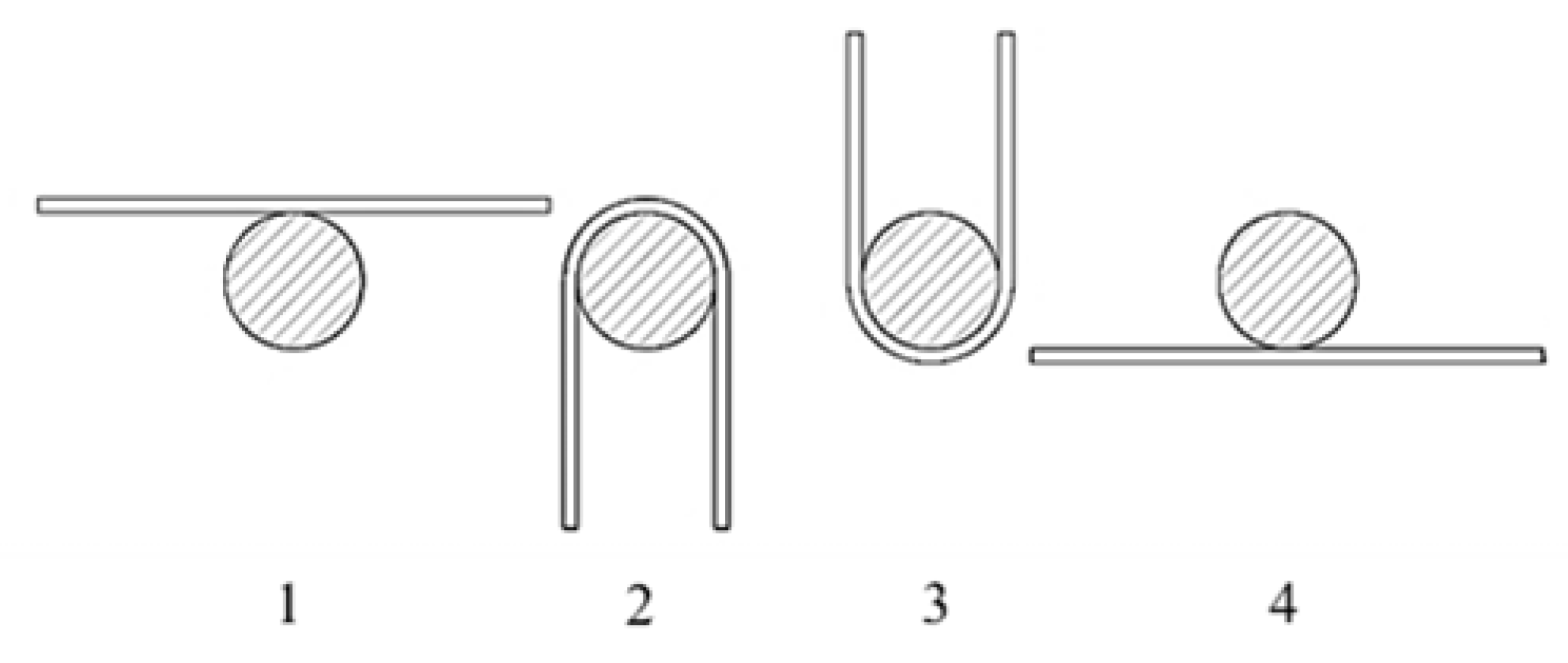
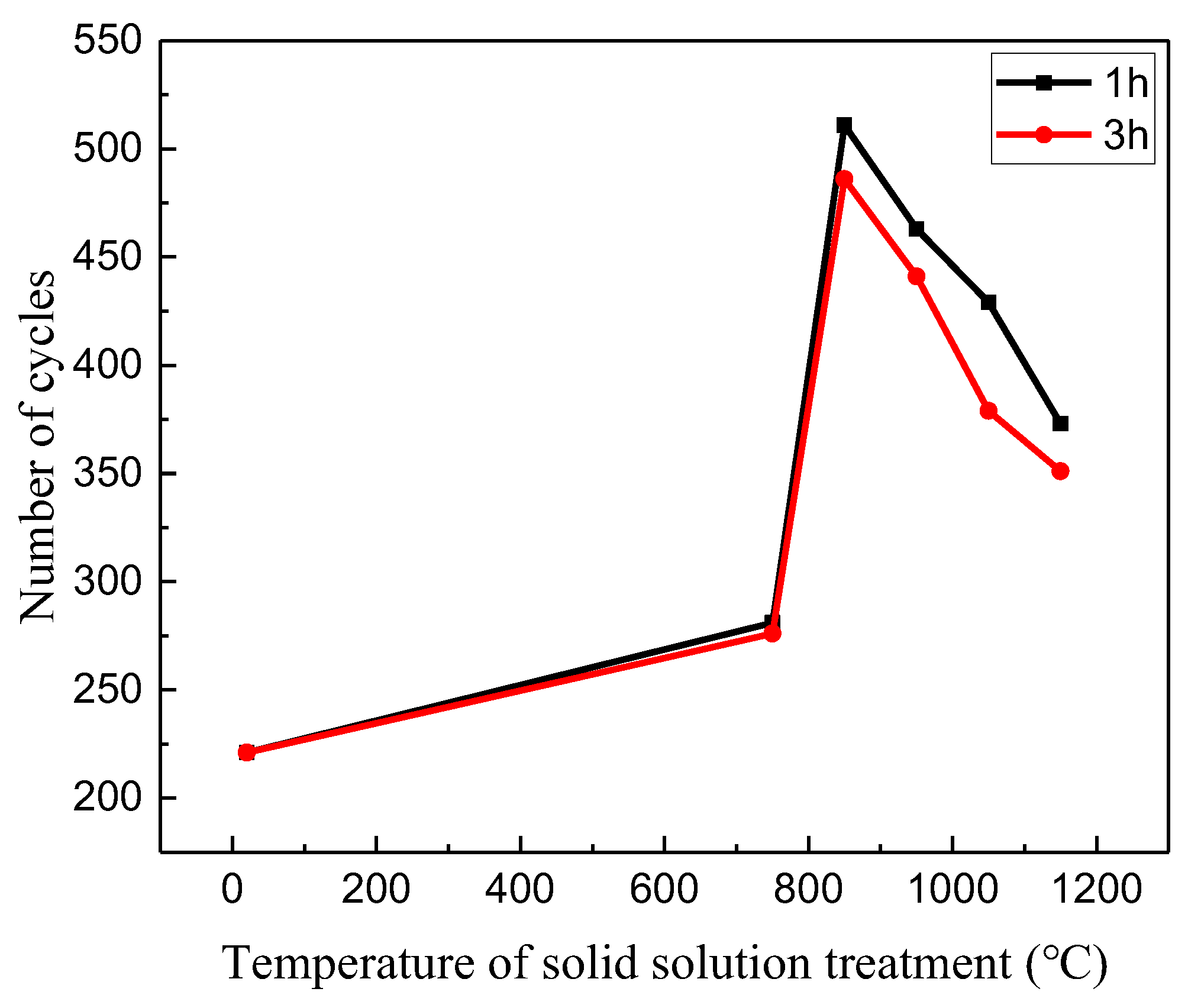
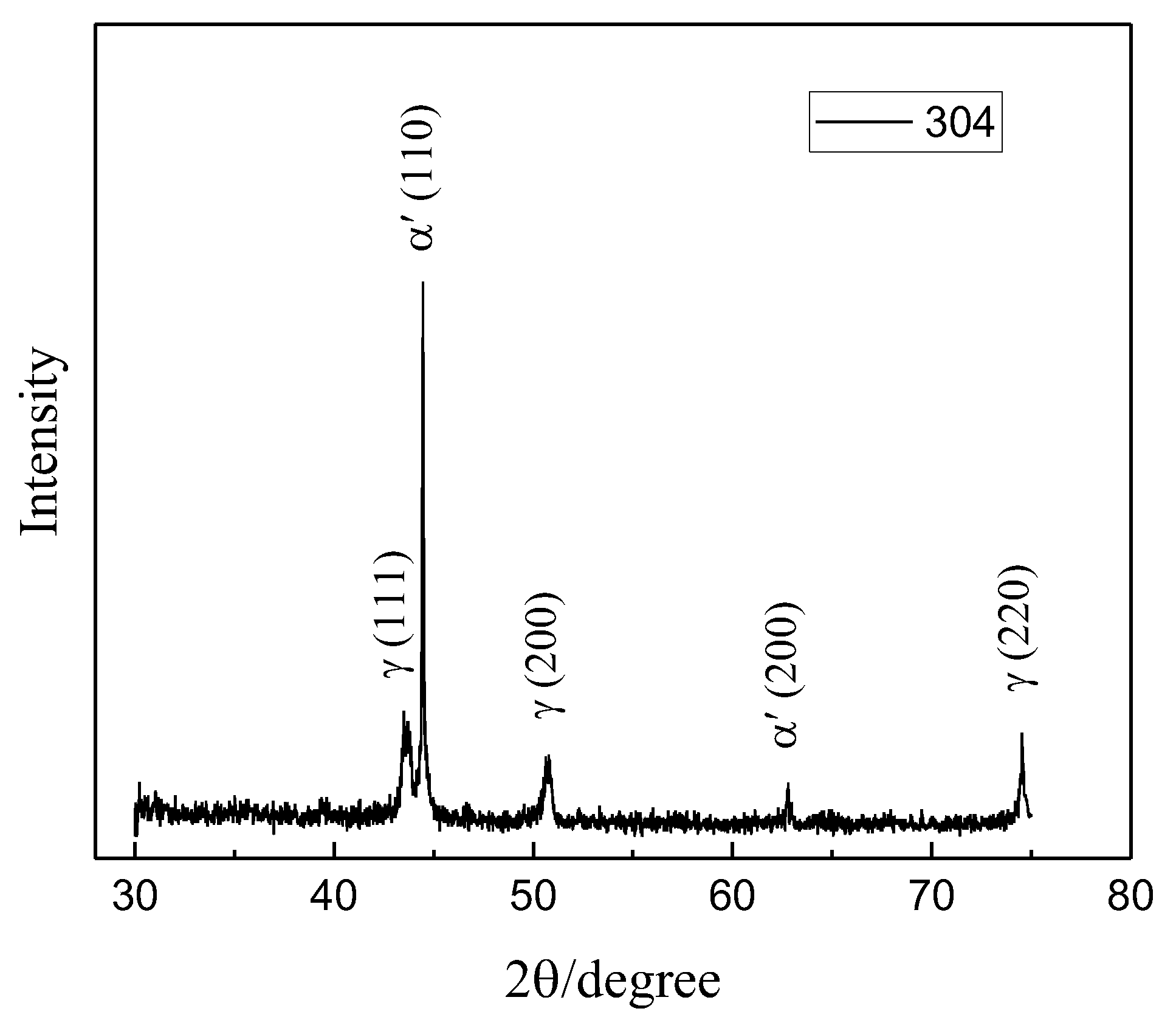
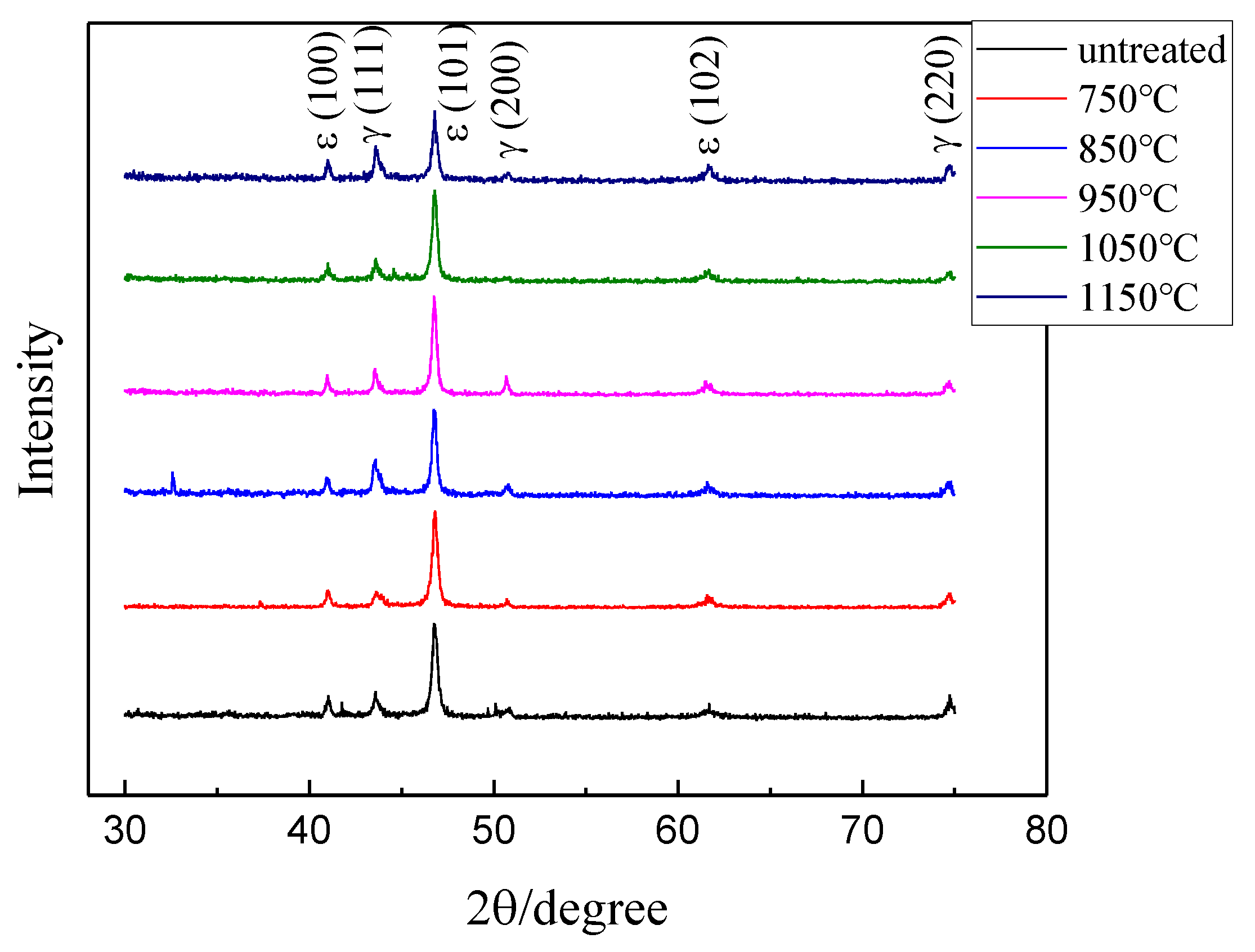
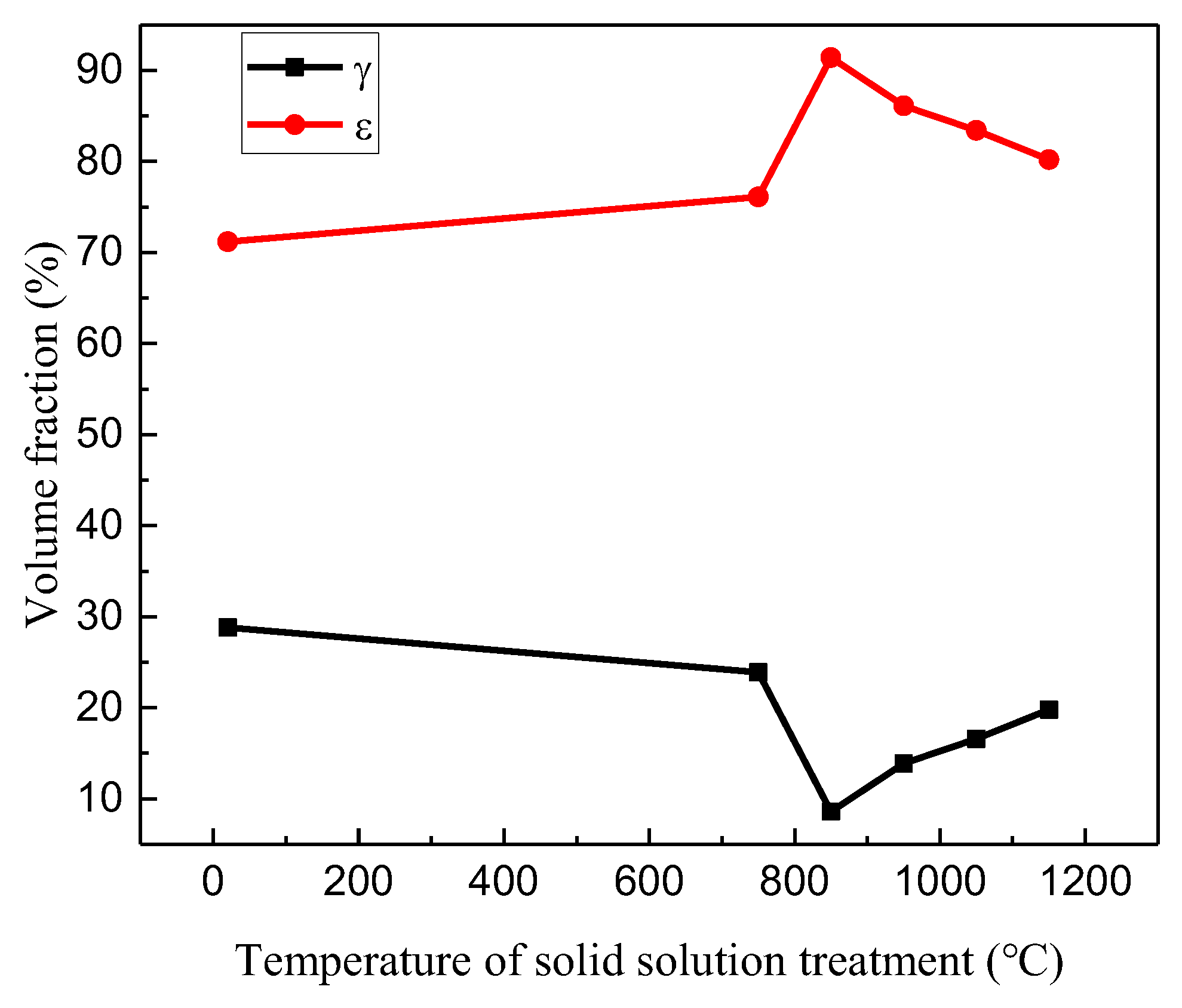




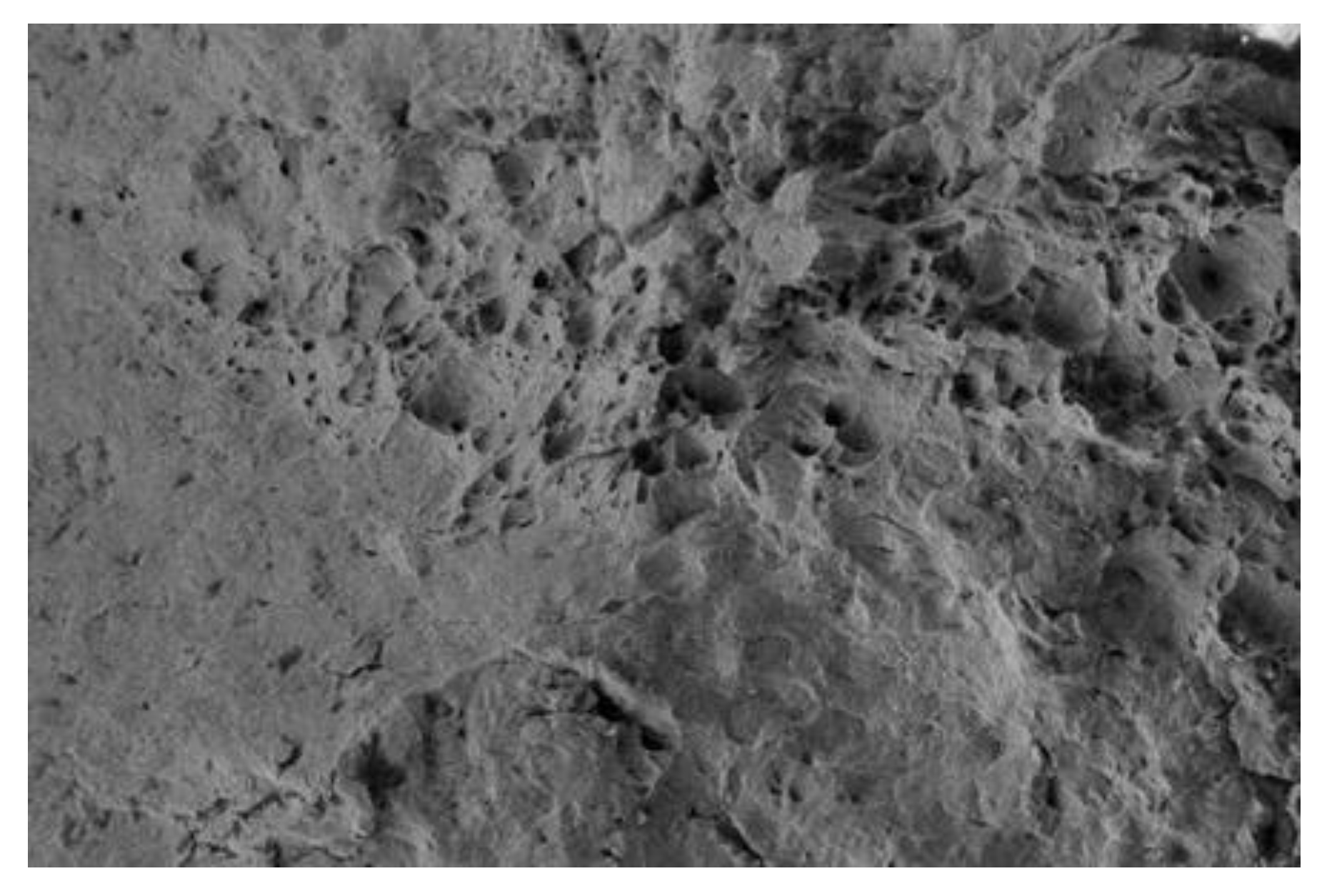
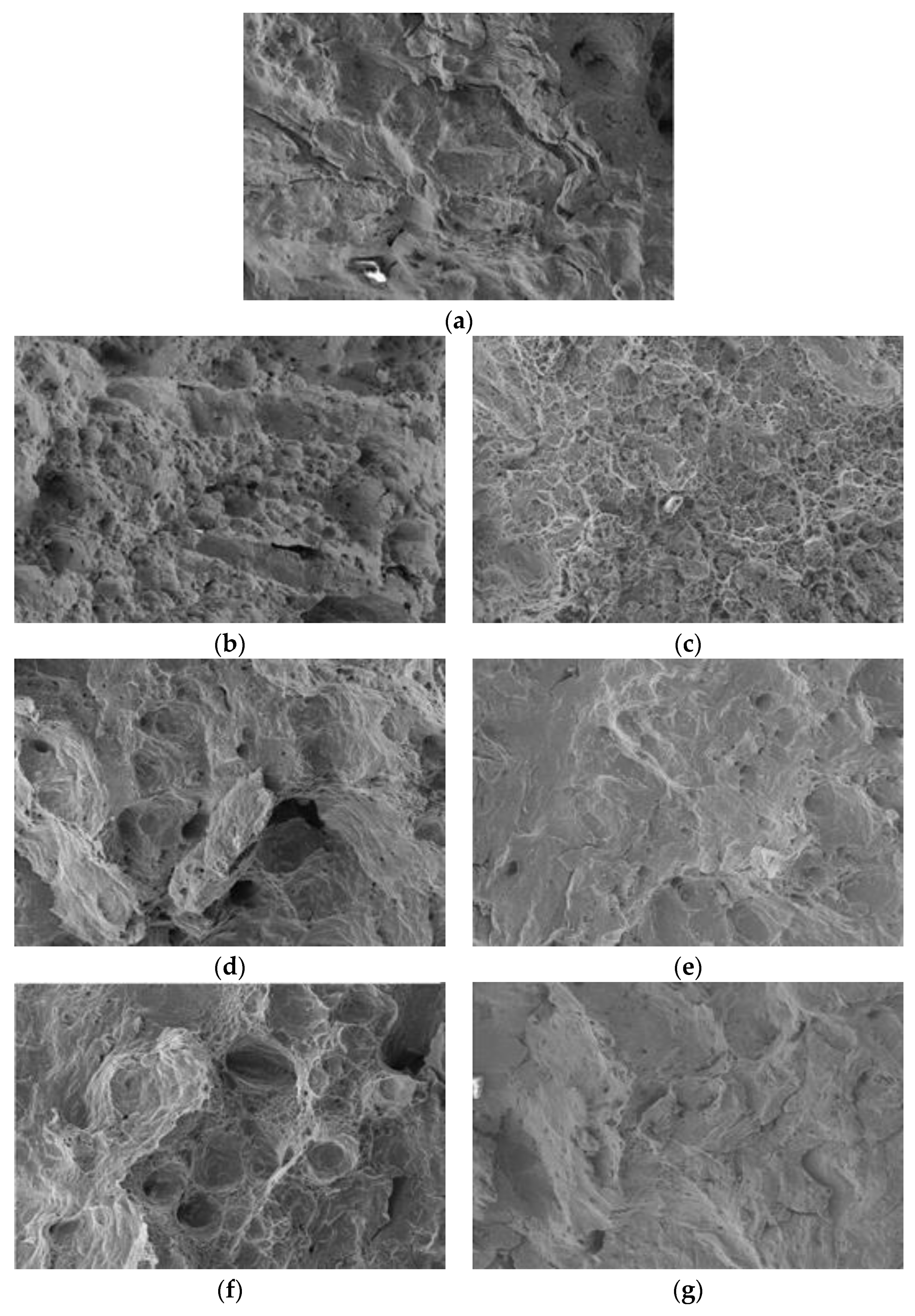
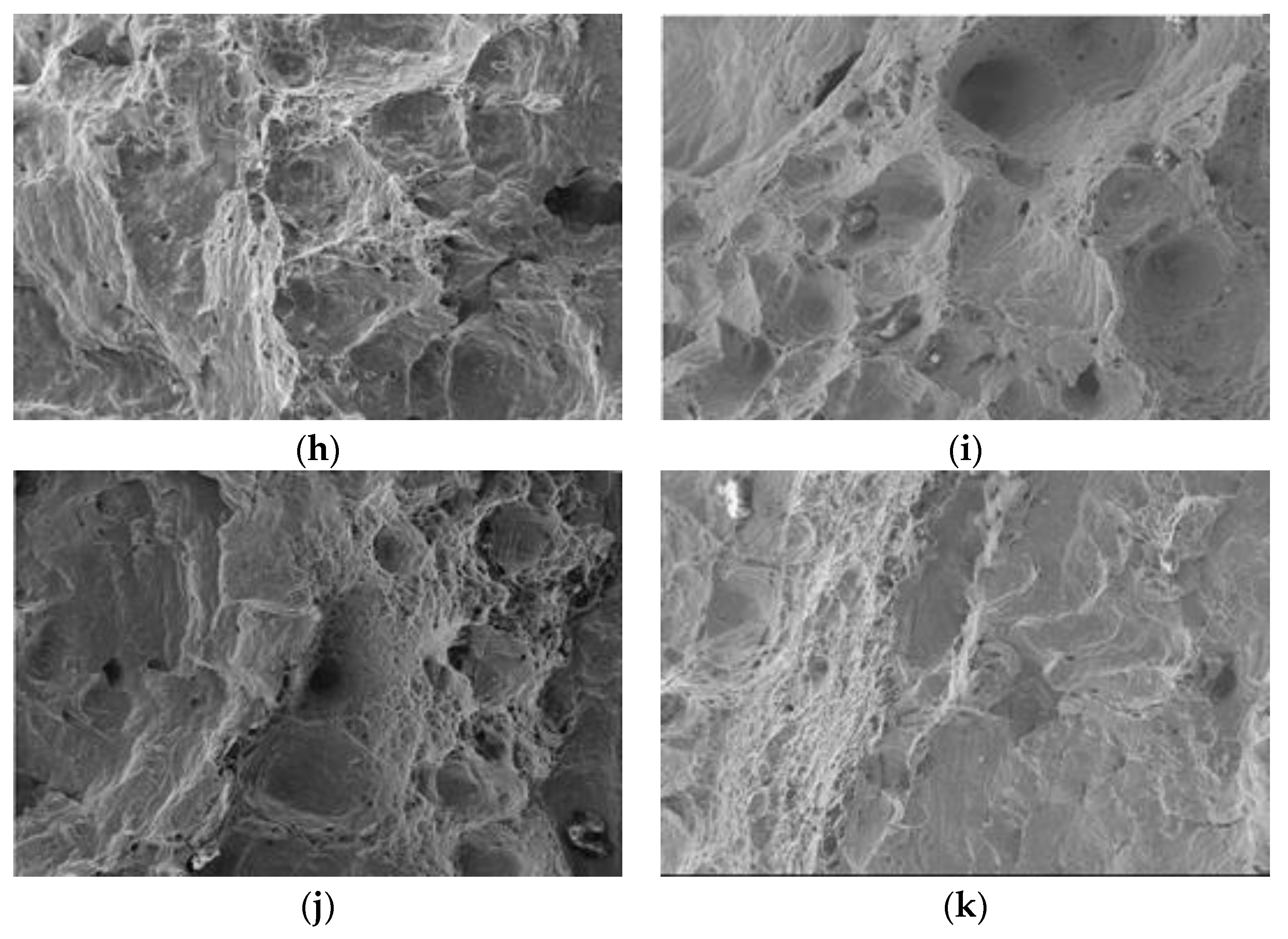
| Chemical Element | Mn | Si | Cr | Ni | Fe |
|---|---|---|---|---|---|
| Mass fraction/% | 17.64 | 4.46 | 10.35 | 5.03 | Bal. |
| Solid Solution Treatment | Untreated | 750 °C | 850 °C | 950 °C | 1050 °C | 1150 °C | |||||
|---|---|---|---|---|---|---|---|---|---|---|---|
| 1 h | 3 h | 1 h | 3 h | 1 h | 3 h | 1 h | 3 h | 1 h | 3 h | ||
| Number of cycles | 221 | 281 | 276 | 511 | 486 | 463 | 441 | 429 | 379 | 373 | 351 |
Disclaimer/Publisher’s Note: The statements, opinions and data contained in all publications are solely those of the individual author(s) and contributor(s) and not of MDPI and/or the editor(s). MDPI and/or the editor(s) disclaim responsibility for any injury to people or property resulting from any ideas, methods, instructions or products referred to in the content. |
© 2024 by the authors. Licensee MDPI, Basel, Switzerland. This article is an open access article distributed under the terms and conditions of the Creative Commons Attribution (CC BY) license (https://creativecommons.org/licenses/by/4.0/).
Share and Cite
Niu, H.; Sun, Y.; Lin, C. Study on the Effect of Solid Solution Treatment on the Bending Fatigue Property of Fe-Mn-Si Shape Memory Alloys. Metals 2024, 14, 441. https://doi.org/10.3390/met14040441
Niu H, Sun Y, Lin C. Study on the Effect of Solid Solution Treatment on the Bending Fatigue Property of Fe-Mn-Si Shape Memory Alloys. Metals. 2024; 14(4):441. https://doi.org/10.3390/met14040441
Chicago/Turabian StyleNiu, Haojie, Yubin Sun, and Chengxin Lin. 2024. "Study on the Effect of Solid Solution Treatment on the Bending Fatigue Property of Fe-Mn-Si Shape Memory Alloys" Metals 14, no. 4: 441. https://doi.org/10.3390/met14040441




